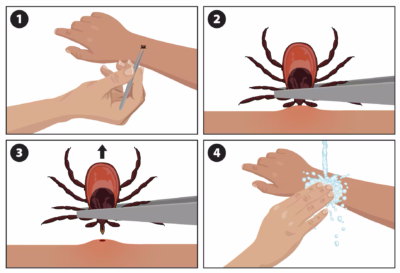It’s already been a busy start to the year for Medina County and the State of Ohio when it comes to reported tick cases and is only expected to continue. In 2012, Ohio had 67 reported cases of tick disease, while in 2021 that number has jumped up to 590. The two most likely ticks you will encounter in Ohio are the American Dog tick and the Blacklegged (deer) tick. To prevent tick-borne diseases here are some myths, tips and tricks to ticks
Myths:
Myth: Ticks are only active during warmer months
Fact: While ticks are generally more active during the warmer months, they are weather resilient and winter tick bites can happen.
Myth: If you bring a tick in for testing, the state will test for disease
Fact: The state only tests the tick to see if it was engorged (did the tick feed). The state will not and does not test for disease potential.
Myth: You can bring ticks in that you found on your pet in for testing
Fact: The health department does not submit ticks if found on your pet.
Myth: I should get antibiotics after a tick bite
Fact: Generally, infectious disease experts do not recommend the routine use of antibiotics following a tick bite in Ohio as a way to prevent tick-borne diseases. This type of treatment, called post-exposure prophylaxis, is sometimes used in states with high incidence of Lyme disease, such as some New England states, but is not recommended in low incidence states such as Ohio.
Myth: All ticks carry Lyme disease
Fact: While the disease is one of the most common tick-borne illnesses, the only tick that carries the disease is the Blacklegged Tick (aka Deer Tick). While the blacklegged tick is common in Ohio, not all blacklegged ticks carry the disease, and the ones that do carry Lyme disease must be attached for 24 hours or more to transmit the disease.
Tips & Tricks
Preventing the bite
- Use EPA registered insect repellents that contain DEET.
- Know where to expect ticks. Ticks live in leaf litter, grassy, wooded or brushy areas, some even live on animals. Walking your dog, gardening or hunting could bring you in close contact with ticks. Many people get ticks in their own yard.
- When walking on trails, stay in the center of the trail.
- Wear long, light clothing in the summer time when outside in these areas.
After You Come Indoors
- Check your clothing; ticks may be carried into the house on clothing. Tumble dry clothes in the dryer on high heat for 10 minutes. If clothes need washing, use hot water. Cold and medium temperatures will not kill ticks
- Examine your pets and gear. Ticks may also come indoors through your pets and outdoor gear.
- Bathe or shower as soon as possible after coming indoors to easily find and wash off any ticks that may be on you.
- Conduct a full-body check using a mirror to see if any ticks are on you.
What If You Get Bit
- Remove ticks immediately. Use fine-tipped tweezers to grasp the tick, close to the skins surface. Do not twist or jerk, but instead pull away from your skin with steady pressure. Methods like petroleum jelly, hot matches, dish soap, or nail polish to remove ticks do not work.
- Wash the bite area with soap and water.
- Check regularly for symptoms. Most common symptoms of tick-related illness are fever, chills, aches and pains, and rash. See your healthcare provider immediately if you have been bitten and experience any of the common symptoms.
- To dispose of a live tick, put it in alcohol, placing it in a sealed bag/container, wrap it tightly in tape, or flush it down the toilet. Never crush a tick with your fingers.
- Residents are able to bring in ticks removed from their skin, in a bag or container, to the health department for free. We use a high definition, microscopic camera to send pictures to the Ohio Department of Health, where we get information on if the tick has fed, and what species of tick it is.
For more information on ticks or our Tick Surveillance program in partnership with Ohio Department of Health, contact our Environmental Health Division at 330-723-9688, option3










